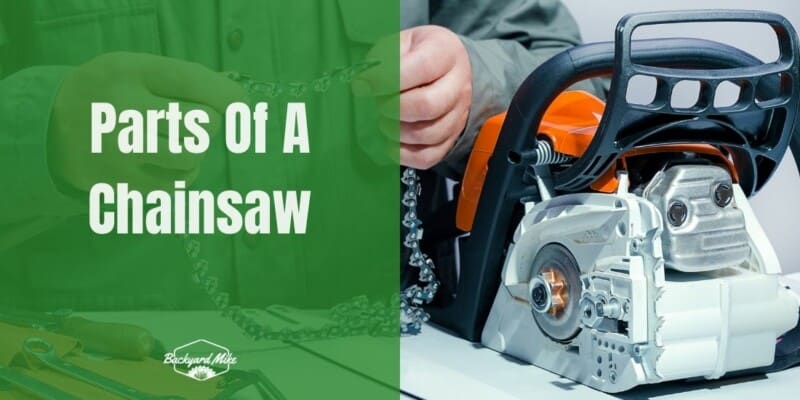Are you a beginner having difficulty working out the different parts of a chainsaw? Worry not, every chainsaw user starts from zero, and they have been a novice at some point. In this article, you will get to know all about the different parts of a chainsaw and its functions.
A chainsaw is an incredibly handy tool with several important components that come together to help you cut trees. Some of the parts of a chainsaw that you should know about include the engine, the throttle, handguard, fuel tank, air filter, choke, and more.
A complete breakdown of different parts of a chainsaw
There are a few OSHA required components recommended that your chainsaw must-have. Here are the different parts of a chainsaw that you should know about.
Engine
The engine is the basic equipment for running the entire chainsaw. Any talk of chainsaw components without mentioning the chainsaw engine will be like talking about human anatomy without the heart. It is essentially an essential metal block with black nuts, having rubber wrapping behind the spark plug.
All the standard gas-powered and electricity-powered chainsaws use an engine. In the engine, there are lines attached behind the spark plug for running across with the help of a lubricant. Apart from lines, models like electricity and battery-aligned chainsaws are updating their engine functions. This will help improve the performance and make the chainsaw lightweight.
Chain
The chain is one of the most vital parts of a chainsaw. It accommodates the cutting and pruning job of the wood. It is wrapped around the guide bar and must be kept sharp at all times. In general, the chain and guide bar are essential not just for cutting but for handling the chain brakes.
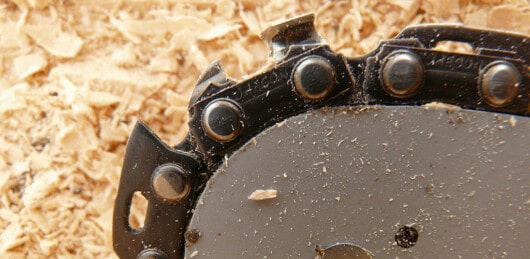
Apart from the availability of different chain parts and their different sizes, it is important to have sharp teeth on the chain. These sharp teeth are what you call “gauges”.
Sprocket
Many people get confused between a sprocket and a clutch, but the two are very different aspects of a chainsaw. A clutch is essentially a small, thin metal ring covering the underneath surface of the metal disc. When you use the handbrake for safety reasons, it activates the clutch.
How the clutch stops the chain from spinning is done by squeezing the sprocket. The sprocket is the metal component of the ring. The small teeth on the sprocket are what help the chainsaw chain spin.
Handguard/Chain brake
The handguard ensures that the chainsaw doesn’t slip from your chain or hit the chain with your hand. It is an essential component that helps with the safety aspect.
It also serves as the chain brake and when you press against it, it’ll activate the clutch, stopping the chain.
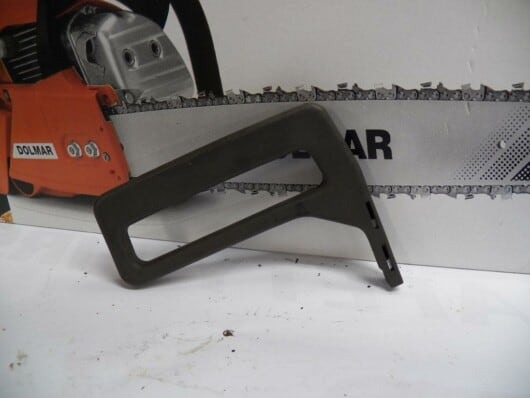
Anti-vibration handle
All standard chainsaws these days come with an anti-vibration handle system. This system is designed to effectively reduce the strain on the operator’s hands and arms. A common issue with using chainsaws is that if you use them for long, the vibrations can injure you. An anti-vibration handle will help you avoid any serious injuries.
In an anti-vibration handle, a spring is used for absorbing the motion caused by the gas engine. This component is important when you’re using a chainsaw for long durations. It also helps avoid sound so that you don’t distract yourself or your neighbors.
Muffler
The muffler is also a key component in your chainsaw. It plays the same role as it plays in a car. The muffler reduces the noise of your chainsaw and ensures you don’t lose concentration or disturb the entire neighborhood.
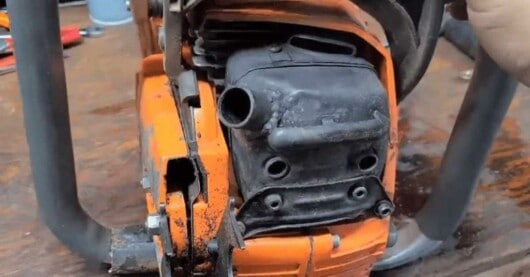
Besides dampening the noise, it’ll also keep the operator’s ears from getting damaged while working long hours. A gas-powered chainsaw is known to create louder noises as compared to battery-powered chainsaws.
Chain catcher
A chain catcher is an important safety feature that any standard chainsaw must have. And it does just what the name suggests. In case your chainsaw chain breaks or comes loose, it could potentially injure you. It can easily wrap all the way around the bottom of your chainsaw and hit you. To prevent injuries, there is a small metal hook that is intended to stop the chain short. This is possible thanks to the chain catcher.
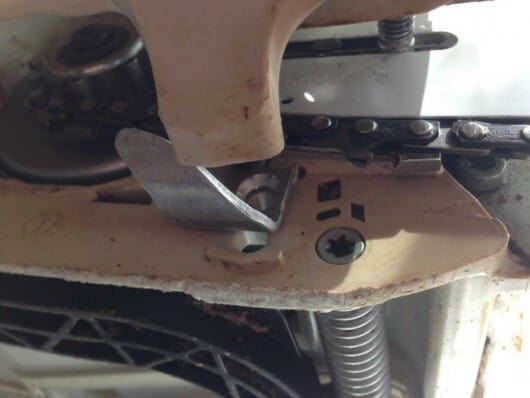
Sometimes, the chain catcher is made up of plastic. However, the plastic chain catchers aren’t as strong to withstand the force. It would be a better option to have a metal chain catcher in your chainsaw.
Spark arrestor
A spark arrestor is a mesh-like screen that comfortably sits towards the inside of the muffler. The function of the chainsaw’s spark arrestor is to prevent small projectiles (such as small metal pieces) from flying out of your chainsaw. Having a spark arrestor in your chainsaw is essential as it prevents potential injuries. Moreover, in certain situations, a spark arrestor will also prevent fire hazards.
Bucking spikes
The bucking spikes in your chainsaw are the helpful components that help in cutting trees into logs. When you’re driving the bucking spikes into wooden pieces, it’ll stabilize the chainsaw and give you the needed leverage. This will make it far easier to make the needed cuts. Thanks to the bucking spikes, the chainsaw does all the work instead of you straining your body.
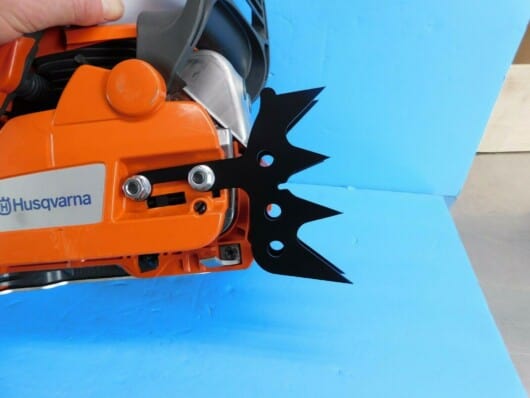
Fuel tank
The fuel tank is another excessively important component in your chainsaw. The fuel tank is where you should put the gas/oil fuel mixture in the chainsaw. Most standard chainsaws tend to use a mix ratio of 50:1. Using the wrong mixture will end up damaging your chainsaw, while also putting you at risk of potential accidents. The fuel in the fuel tank will keep your engine running smoothly, helping you cut and prune without hiccups.
Lubricant tank
The lubricant tank is where you add the bar and chain oil into your chainsaw. It is as important as the fuel tank. Bar and chain oil is an important lubricant, and it reduces the friction and heat created by the metal-on-metal contact between the chainsaw’s chain and bar. Not only will the lubricant reduce the friction and sounds, but it also diminishes the heating parts.
Pull cord
A pull cord is used for turning on the engine and helping it get started. It is made using a small role with an attached plastic handle.
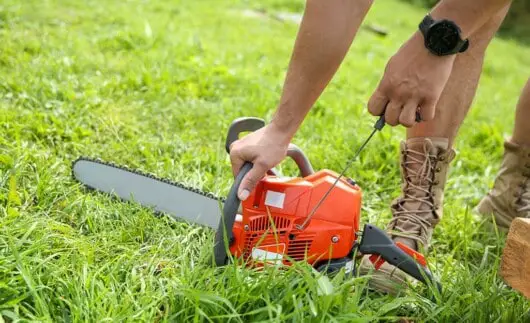
A gas-powered chainsaw is started as you pull the aforementioned pull cord and rev up the throttle. You should make sure that the pull cord isn’t too short or you’ll have trouble starting the chainsaw. Moreover, you shouldn’t mishandle the cord or pull it too fast or pull it the wrong way. It could break the cord and put you at risk of potential injuries.
Spark plug
If you own a car, then you’ll probably know what a spark plug is. The spark plug used in the chainsaws is much smaller than the version used in a car engine. The primary purpose of the chainsaw spark plug is to ignite the fuel in the chainsaw engine.
Similar to an air filter, the spark plug in your chainsaw can easily get worn out over time. You will then need to get it repaired or even get it replaced. When you need to replace your spark plug will depend on multiple factors. Some of the factors include how rigidly you use your chainsaw or how frequently you use it.
Air filter
The air filter in your chainsaw will help you get the right air-to-fuel mixture heading into the engine. The air filter is one of the most significant components of your chainsaw. Any damage to the air filter will directly affect the performance and longevity of your chainsaw. If your air filter gets dirty or clogged, you’ll need to clean it up instantly, or you’ll struggle to use the chainsaw. Similarly, if it gets damaged, you’ll have to replace it quickly as it could put you at risk of potential injuries.
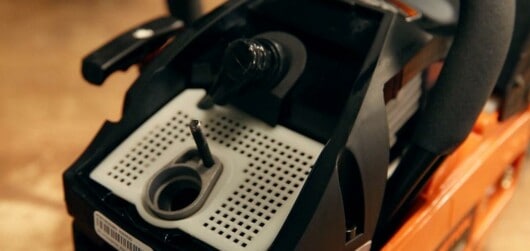
High/low adjustment
In the chainsaw, there are a set number of adjustment screws that you should tune from time to time. The two screws on top are marked with “H” and “L” and they’re called the High/Low adjustment screws.
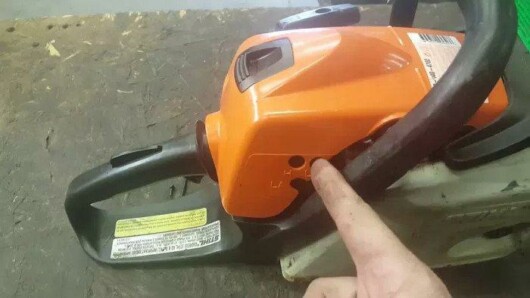
These screws will control the idling speed of the chainsaw. This is done by slightly tweaking the maximum and minimum RPM. The entire process to make the high/low adjustments can be quite tricky. This is why, whenever you need to move the screws around, you should consult the instruction manual of the chainsaw.
Lean adjustment
Near the high/low adjustment, there will be an additional hole marked with “LA”. This is common for most standard chainsaws. Inside the hole marked “LA” will be the lead adjustment screw.
The lean adjustment screw will help you control the air/fuel mixture for the chainsaw. This is done by simply changing the input of the fuel into the carburetor. Similar to the high/low adjustment screws, the process to tune the lean can be slightly complex. This is why it is essential to refer to the chainsaw’s user manual for the necessary instructions on how to easily adjust the Lean adjustment.
On/off switch
The on/off switch or better known as the choke is controlled by the one lever placed on your chainsaw. When you need to start a gas-powered chainsaw, you will need to toggle the switch to the “on” position. If you’re flipping the switch up, it’ll be in the “off” position. Further, pulling the switch down will help you use the choke.
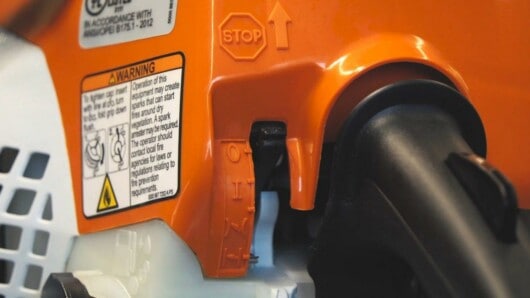
Summer/winter shutter
Similar to the on/off switch, there will be a summer/winter shutter on your chainsaw that is needed when starting it. This small piece of plastic is one of the most common misused components in your chainsaw.
The primary purpose of this shutter is to help you control the airflow in and out of the engine. In the summers, when there are warmer climates, you would want the chainsaw engine to pull the air from outside the chainsaw as it’ll be cooler than on the inside. Similarly. During winter, you’ll want the engine to pull the warm air inside the machine instead of the cold air outside.
The summer/winter shutter in your chainsaw will allow you to easily control the airflow. It does that by blocking or opening the small passageway inside your chainsaw. Further, it is important to keep in mind that this point will look different for different chainsaws. However, the basic function of all the chainsaws is the same.
Throttle
The throttle is the trigger piece located on the interior of the chainsaw’s handle. It is basically the gas pedal in the chainsaw that sends the fuel and runs the engine. However, it is important to remember that the throttle trigger will not function unless you keep the throttle interlock pressed.
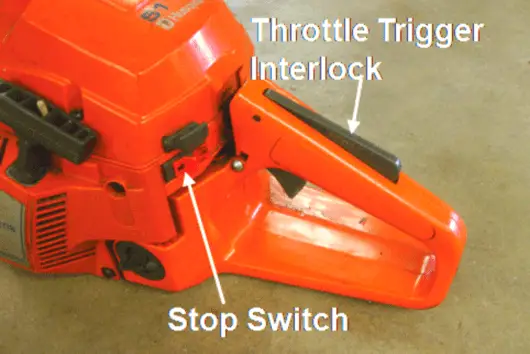
Decompression valve
The decompression valve isn’t a necessity, and it is only found on certain chainsaw models. The decompression valve is used for releasing the pressure from the chainsaw pistons, making it easier to start the engine.
Conclusion
As you can see from the article, a chainsaw is full of complex parts. There are many components that come into play to help the tool start, keep it running, and perform tasks safely. This article featured all the important parts of a chainsaw and its functions. If you know about all the parts and their functions, it’ll help you understand the inner workings of the chainsaw. It’ll help you not just run your chainsaw smoothly, but also improve the performance of the chainsaw.

